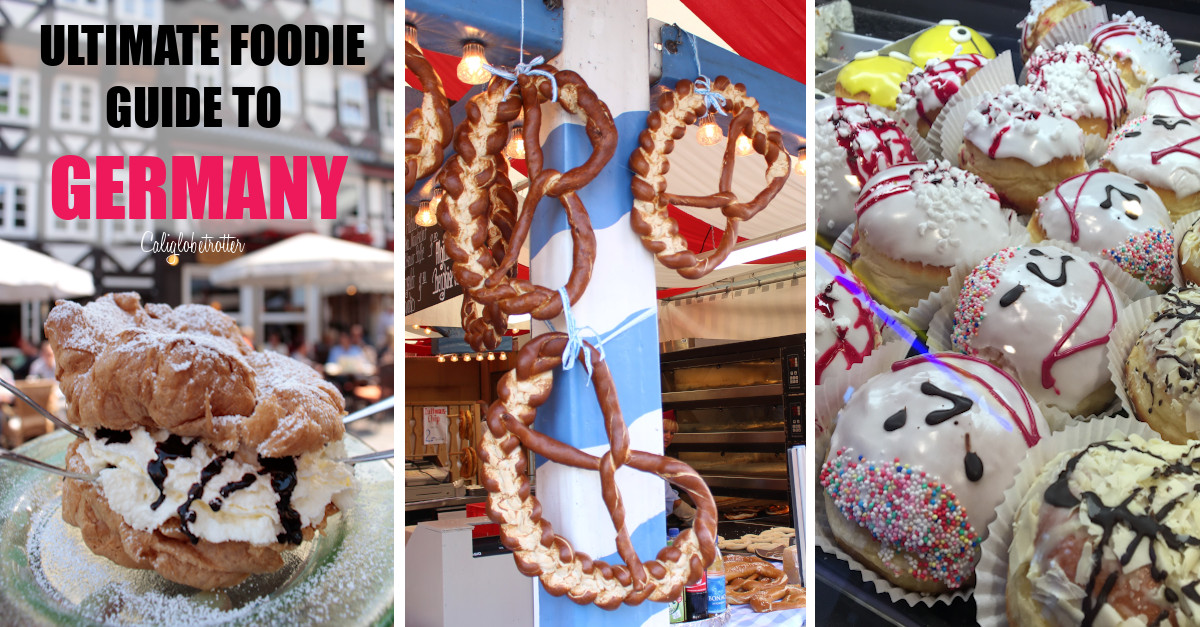
Disclaimer: This post contains affiliate links. If you click on one and make a purchase, I might make a little extra spending money, at no extra cost to you. As always, all opinions are my own and these products/services have been found useful during our travels and come highly recommended to you from yours truly!
One thing I reiterate often is that when it comes to travel, half the reason why we explore new lands is to try new foods. Just admit it now. Germany has a hearty cuisine with a plethora of traditional meals. And I’m certainly not gonna lie, I love the food. It’s the best way to understand the culture, the people and the traditions.
Hungry yet? Salivate Now and PIN IT FOR LATER!
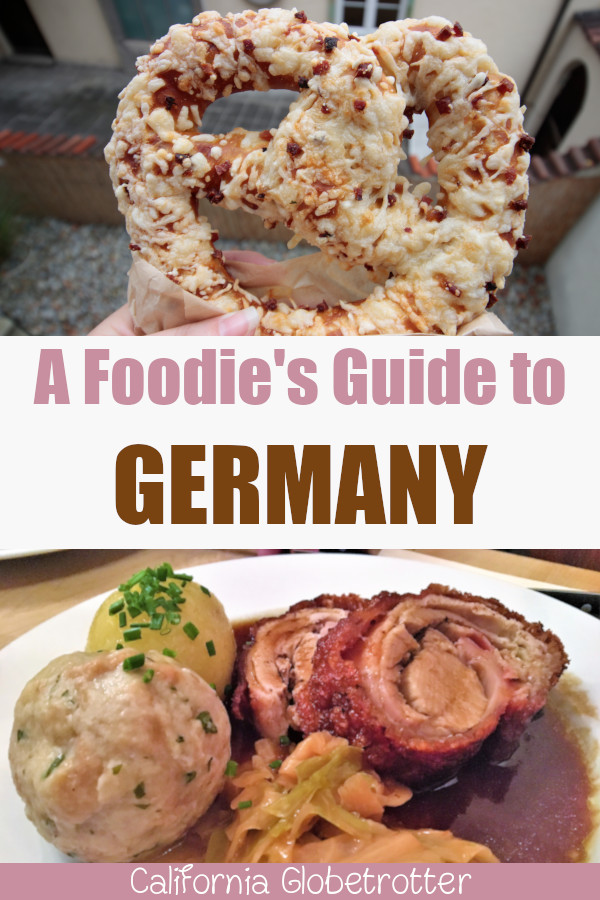
How to AVOID Looking Like a Tourist in Europe
100 Signs You’ve Lived in Germany For Too Long!
15 Things to Do When You Travel
Prior to living in Germany this time around, I had been in Germany several other times. I came once when I was 14 with my family and fell in love with Jägerschnitzel (or sometimes known as Champignon Schnitzel) and Bratwurst. Ever since I was hooked. Then I came for a one month summer exchange program through my high school at 17. I ate more schnitzel and more bratwurst. Then at 20, I spent a year studying abroad in Heidelberg. And guess what… I ate more schnitzel and more bratwurst.
I never knew what anything else was and was too afraid or too picky to try something new. I know, typical teenage girl. But now, I’m kicking myself for all those years I didn’t eat all that delicious food!
This time around, it helps having Germans around to help teach you what other good German food there is beyond the world of schnitzel and bratwurst! Plus, I made it my goal this time around that I would learn more about the German cuisine. And let me just tell you, I regret my younger days having never tried other good German good because it’s gooood!
So, I’ve compiled a list of foods to eat while in Germany that are not to be missed! Now, I have only really traveled around Southern Germany, but as you can usually find the same things everywhere you go, it shouldn’t be hard to stumble upon one of these good meals!
Breakfast
Continental Breakfast
If you’re traveling to Europe, you’ll find that the standard breakfast in many hotels all offer a Continental Breakfast. This usually just includes bread rolls, slices of cheese and meats, spread such as butte, jams or Nutella as well as a 3-Minute egg. Simple, yet completely satisfying!

Weisswurst mit Brezn (White sausage with Pretzels)
Created in Munich, this is predominantly a Bavarian breakfast that is eaten before noon. You are usually served two white sausages, which you need to cut down the middle and peel off the skin before eating!! Served with a pretzel and Händlmaier’s Sweet Bavarian Mustard. Slice a piece of your wurst, dip it in the sweet mustard and swallow with a bite of pretzel. Then wash it down with a beer. In the morning. Yes, I said in the morning.
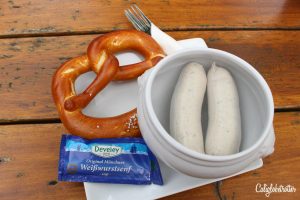
Lunch / Light Snacks
Brotzeit (Bread time)
For those afternoons and evenings that are either too hot or too late to cook something, this is quick and easy. Usually just a platter of different meats such as salami, ham, chicken slices with cheeses and spreads. Simply grab a slice of bread, spread on some cheese, butter or another spread and slap a few slices of salami on your bread with a cold beer to wash it down and you have yourself a hearty Brotzeit.
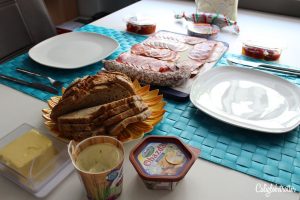
Brez’n (Pretzels)
You could even opt for a massive, fluffy and warm Pretzel. All German bakeries have an endless supply of fluffy pretzels, although not nearly as large! These are reserved more for Volksfests! You’ll often find various types of Pretzels for example with cheese and bacon (Käseschinken Brez’n) as well as with or without salt. These fancy-schmancy pretzels can mostly be found at beer festivals like the Regensburger Dult.
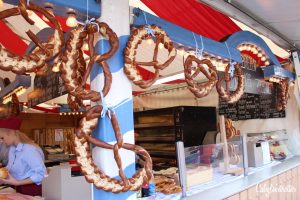
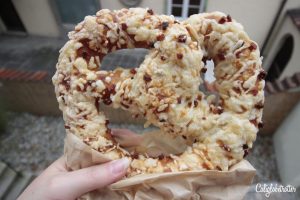
Obatzda
Is a cheesy delicacy popular in Bavaria which blends Camembert and a lot of butter seasoned with paprika powder salt and pepper but can also be blended with Frishkäse (a type of cream cheese) and Brie. It is traditionally served with sliced red onions as well as either pretzel sticks or a few slices of bread, and let me tell you, there is never enough bread so don’t be shy to ask for more. However, Bavarians are fine just eating the Obatzda without pretzels or bread. For it to be considered true Odatzda, it MUST be made in Bavaria!
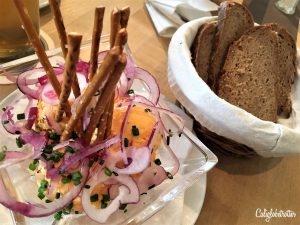
Döner Kebab or Durum
While Döner originates from Turkey, it is one of the most integrated popular meals you can find in Germany. Germans love love LOVE their Döners which can be found practically everywhere and is a form of fast food. It is a Turkish style gyro made of meat shaved off of of a spinning rotisserie before being stuffed into a pita bread (Döner) or a tortilla style burrito (Durum). You can add red cabbage, salad, feta cheese, onions, tomatoes or corn and drizzle a white garlic sauce, a plain yogurt sauce or a spicy sauce as well as add other seasoning like curry. I’m rather a “Plain Jane” and like to ask for extra meat. Pack it to go (zum Mitnehmen) or eat it now (zum gleich Essen). You can also get it in a box with fries sort of like carne asada fries.
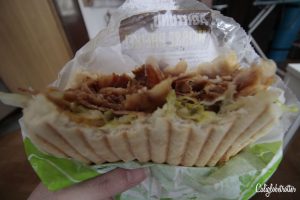
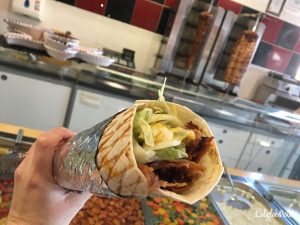
Currywurst
If Germans aren’t eating a Döner, their eating a Currywurst which is a pork sausage seasoned with a curry ketchup sauce and a side of fries and is another form of fast food that is popular in Germany and can be found practically everywhere. Not a fan of the sauce? Ask for it on the side or just a little bit (nur ein bisschen Sauce).
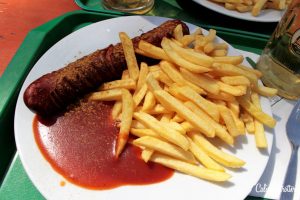
Leberkäse Semmel (aka Fleischkäse)
Another popular light lunch or dinner is a Leberkäse Semmel which is similar to a bologna sausage. No there is no liver in the meat despite the name, but instead corned beer, pork and bacon grinded together very finely and cooked in a bred pan to become crunchy on the outside. Can be served with or without the bread roll, you can have sweet or normal mustard added to it or it can come served with a side of Potato Salad (Kartoffelsalat). You can occasionally find a Leberkäse Pizza with peppers and cheese inside. Take it to go (zum Mitnehmen) or eat it now (zum gleich Essen).
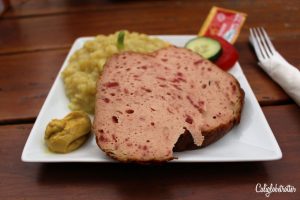
Schnitzelsemmel (Schnitzel Sandwich)
If you’re not intersted in trying the Leberkäse Semmel, you’ll be safe and enjoy a Schniztel Sandwich. The schnitzel can either be breaded pork or chicken schnitzel and is often served with ketchup or mustard, but I always ask for Mayo but rarely find it. Again, take it to go (zu mit nehmen) or eat it now (zum gleich Essen).
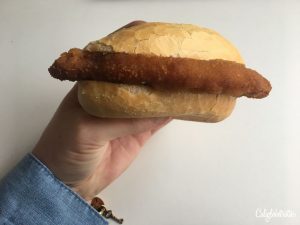
Bratwurstsemmel (Bratwurst Sandwich)
Like the previous, this is another simple meal to go which is just a Bratwurst in a bread roll. The sausages vary depending on the region you’re in and is usually served with ketchup or mustard and occasionally grilled onions. You’ll find many cities have small stands set up throughout the town so you can grab one to go.
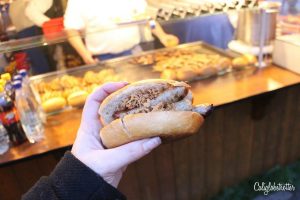
Bratwurst und Sauerkraut mit Süßersenf (Bratwurst with Sauerkraut and Sweet Mustard)
While you can typically find a regional bratwurst anywhere you go in Germany, one of the best, and maybe because I’m biased, is from right here in Regensburg with our city’s famous Sweet Mustard! Grab a plate down by the banks of the Danube River at Germany’s oldest Sausage kitchen!
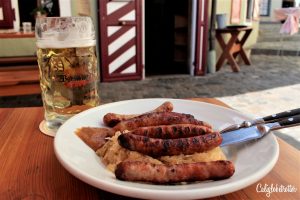
Dinner
Spargel mit Schinken, Kartoffeln und Hollandaise Sauce (Asparagus with Ham & Hollandaise Sauce & Potatoes)
Between the months of April and June, Germans go crazy for Asparagus (Spargel) and so should you! Known as “White Gold”, asparagus is a popular dish and is also referred to as the Royal Vegetable” dating back to King Louis XIV of France. Most commonly eaten is the White Asparagus served with a side of ham and potatoes and covered in Hollandaise sauce. During this time many other meals are served with a side of asparagus.
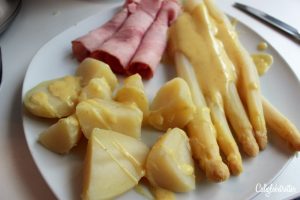
Cordon Bleu
Cordon Bleu is Cordon Bleu wherever you go. Here in Germany, you can get it anywhere and it’s made from pork schnitzel and stuffed with ham and a strong cheese such as a Gruyère cheese or other Bergkäse (mountain cheese) which has a good flavor and melts easily. Typically a Cordon Bleu is served with either fries or roasted potatoes.
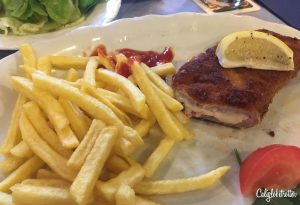
Schweinebraten mit Knödel (Roasted Pork with Potato Dumpling)
This savory hot dish is best served when its cold outside unless you can handle the heat! This roasted pork comes served either with or with the delicious crust, but I prefer the crunchy delicious goodness. A delicious, brown gravy is poured over the entire roasted pork for you to lick up with your meat and the potato dumpling. Now, a potato dumpling (Knödel) is just a round ball of potato cooked in water, a little sticky but good! Normally, you are served with two large portions of potato dumplings, so there is plenty to get every drop of gravy! Usually, Red Cabbage (Blaukraut) is served on the side.
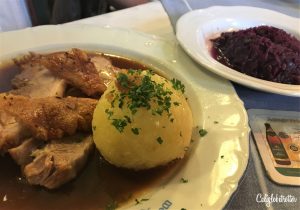
Ente mit Knödel (Duck with Potato Dumpling)
Duck is very common here in Germany. I grew up eating chicken or turkey, but in my opinion duck is way more juicy and not nearly as dry. Plus, dark meat is delicious! Again, served with a yummy brown sauce or sometimes an orange sauce with two knödel on the side! You can usually order 1/4 or 1/2 portions of duck. 1/4 is usually plenty unless you’re mighty hungry!
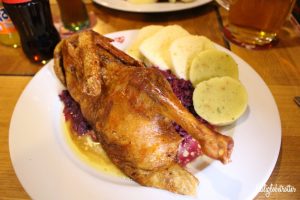
Jägerschnitzel mit Spätzle (Mushroom schnitzel with noodles)
Jägerschnitzel is your standard breaded (sometimes un-breaded) pork schnitzel with a creamy white or brown gravy sauce and sauteed mushrooms. Typically found more often in Bäden-Württemberg than in Bavaria, you can always order a regular Wiener Schnitzel and the mushroom sauce from Rahmschwammerl. But don’t just stick to Jägerschnitzel! Try other variations like Paprikaschnitzel (with peppers), Zwiebelschnitzel (with onions), Bauerschnitzel (Farmer’s schnitzel with bacon and an egg) and sooo many other variations including by far one of the most unique schnitzels in Germany you’ll ever find, a Blueberry schnitzel from Goslar. You can never go wrong!
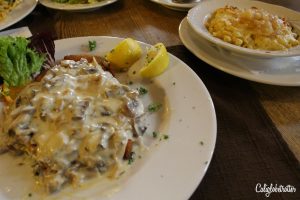
Käsespätzle (Cheesy Noodles)
comes in different forms. Sometimes they a bit round or sometimes stringy soft egg noodles. Sounds funny I know, but it’s good! It’s like eating pasta kind of, and it comes it different forms. But this is my favorite with the mushroom cream sauce mixed in. Other spätzle might come with cheese or bacon and sometimes fried onions. It will leave you wondering why you haven’t been eating this your whole life as compared to the standard mac’n’cheese box.
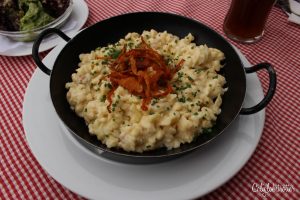
Goulaush (Beef Stew)
Goulaush is a stew/soup filled with meat (beef, pork or venison) and vegetables and seasoned with paprika and often cooked with either a red wine or a beer. Technically, this is a Hungarian dish, but it has a long history of being part of the German culture. This dish is normally eaten with potato dumplings (Knödel) or a plain Spätzle.
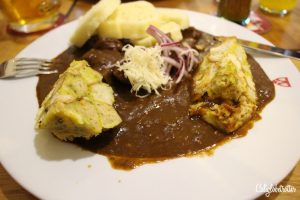
Spanferkelrollbraten mit bayrisch Kraut, Semmel- und Kartoffelknödel (Suckling Pig Roast Roll)
Whew! That was a mouthful! Spanferkelrollbraten literally translates to Sucking Pig Roast Roll which is served with Bavarian sauerkraut and more potato dumplings with a warm brown sauce. It’s so good we decided to have a fancier version of this for our wedding dinner!
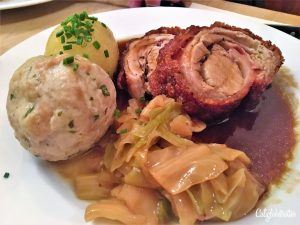
Schweinshaxen (Roasted Pork Knuckle)
The Roasted Pork Knuckle is the pig’s leg, just above the ankle but below the meaty ham portion. It’s a popular dish, especially in Bavaria, roasted on a low temperature to give it a crispy skin and is typically served with cabbage, roasted potatoes or Knödel (potato dumplings).
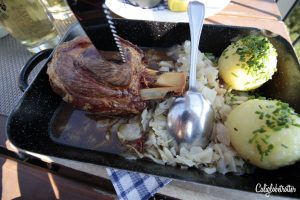
Flammkuchen
Traditionally a dish from the Alsatian region of France called Tarte flambée, this meal has also been incorporated into German culture, most predominately the closer you get to France. Simply a pizza-like dough rolled out into a rectangle or circle, covered in crème fraîche and topped with sliced onions and bacon bits.
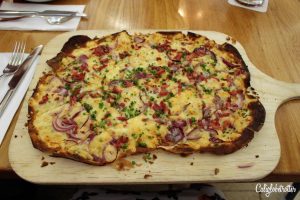
Steckerlfisch (Fish on a Stick)
Kind of like Hot Dog on a Stick but with fish. You can typically find grilled white fish, mackerel or trout on a stick when at a beer festival or biergarten during the summer months which has been a popular meal since the 20th century.
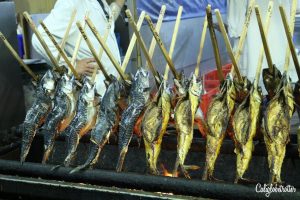
Drinks
Spezi
Germans love to combine a their two favorite sodas into one – Orange Fanta with Coke or Pepsi making for one sweet soda, but it’s goood! Don’t let the name Afri Cola fool you though – it’s a brand for regular coke, so just ignore that!
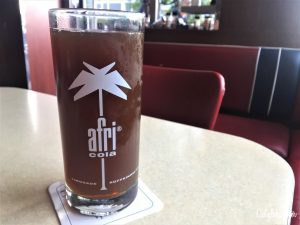
Federweißer
Is fresh wine which has been freshly fermented and can be a bit sparkling. Because of rapid fermentation, Federweißer can not be stored for long and should be consumed within a few days of purchase. However, it typically comes out at the beginning of September and is only available for a few weeks. Get it while it’s fresh! You can find it throughout many of the wine regions in Germany, for example, Rüdesheim am Rhein, but you can also buy it in many grocery stores and is often eaten with Zwiebelkuchen (Onion Tart).
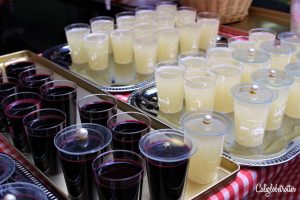
Radler & All Other Beers
Being the sporty, outdoorsy people they are, Germans needed to find an alcoholic drink which they could still drink during biking breaks. Radler is a German word which refers to a cyclist. A Radler is a Helles (Light) or Dunkles (Dark) beer mixed with sparking lemonade.
You just can’t come to Germany without drinking some or a lot of that delicious, perfect beer that has been brewed the same way since 1516 when the Reinheitsgebot (Beer Purity Law) was established. You can find a Helles, a Dunkles, Weizen, Dunkles Weizen, Goaß and so many more!
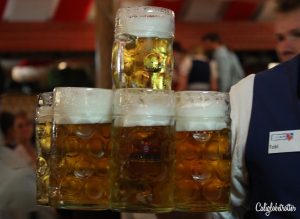
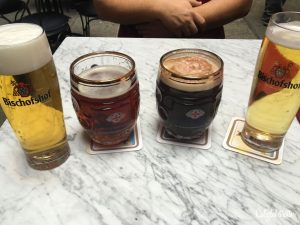
Desserts
Apfelstrudel (Apple Strudel)
A popular Viennese pastry dating back to the Austro-Hungarian empire, no trip to Germany (or Austria) is complete without this warm, melt in your mouth goodness with a side of Vanilla ice cream. This particular Apple Strudel from Passau was inspired by Thanksgiving and every bite tasted just as you would imagine autumn to taste like!
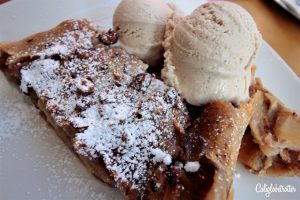
Baumstriezel (Spit Cake)
Are a doughy round piece of heaven, most commonly coated in cinnamon and sugar, but there is a flavor for everyone! These are typically found at Christmas markets as well as at many other festivals throughout Germany, Prague and more
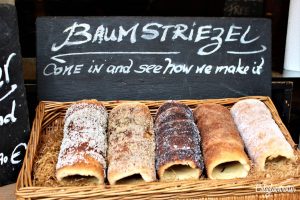
Käsekuchen (German Style Cheesecake)
Similar to the American style Cheesecake, but slightly different as it is made from Quark instead of Cream Cheese and freshly made dough for the bottom layer instead of Graham Crackers. (I still prefer the sweeter American version!)
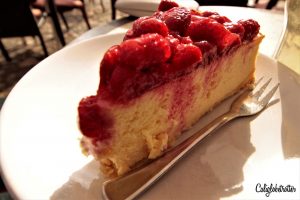
Schneewittchenkuchen (Snow White Cake)
Just the sound of this cake makes it sound interesting. I’ve had this cake once at my boyfriend’s niece’s Firmung (Confirmation) earlier this spring. I knew I immediately had to find the recipe! Being a lover of chocolate and raspberries, I was hooked at first bite! This is a spongey cake, with raspberries and chocolate cooked into the cake, covered in a thick layer of chocolate. You’re not likely to find it in a restaurant but perhaps a German friend will make it for a Coffee & Cake afternoon, but if that doesn’t suit you, you can find the recipe here.
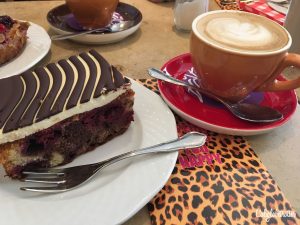
Krapfen (aka Berliner or Pfannkuchen) (Jelly-filled donuts)
This is a traditional jelly-filled pastry donuts covered in powdered sugar that is eaten predominantly around Fasching (Carnival) in February. Germans go crazy for their Krapfen before Lent begins and during Krapfenzeit the donuts are extra special with crazy flavors and designs. However, you can typically find them year round in the basic flavors. This is what JFK mistakenly called himself when he visited Berlin and said “Ich bin ein Berliner!” when we meant that he was one of them!

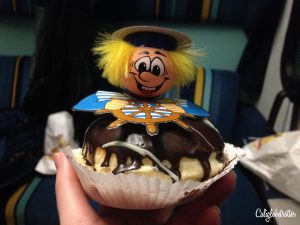
Schneeballen (Snowball)
Is simply a round ball of shortcrust pastry covered in chocolate, vanilla or many other flavors which is especially popular in and around Rothenburg ob der Tauber, but have become quite popular and can be found in Heidelberg and Regensburg as well, and many other places including Wernigerode.

Rieseling Ice Cream
It’s only common sense to enjoy a Riesling flavored ice cream when in the Riesling region of Germany. Found in Bacharach, this was a sweet, sweet twist on your typical ice cream!
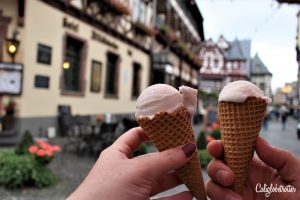
Windbeutel (Cream Puff)
Translating as “Wind bag” is a simple Cream Puff with ice cream and chocolate! Quite popular in Germany, but typically not this big, you can find this beast while visiting Goslar. And this was the “small”! I’ve heard that if you order, eat and finish the large Windbeutel, you’ll get another free.
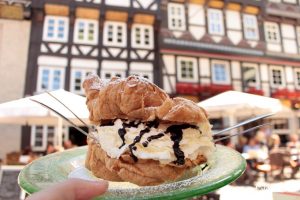
Schwarzwälderkirschkuchen (Black Forest Cherry Cake)
If there was one dessert that was the epitome of German, it would be the Black Forest Cherry Cake – straight outta the Black Forest! It’s a chocolate sponge cake layered with whipped cream and cherries, garnished with cherries and chocolate shavings. What makes it ÜBER special is the kirschwasser – a clear liquor made from sour cherries and by German law, it is not a Black Forest Cherry Cake UNLESS the liquor is in it.
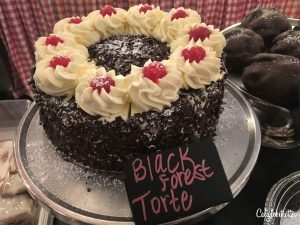
Lebkuchenherzen (Gingerbread Hearts)
One of the most iconic desserts and souvenirs or gifts of affection in Germany which can be found at every single bierfestival like Oktoberfest or Regensburg’s Dult or at Christmas Markets. Germans love to show their affection by buying one of these delicious Gingerbread hearts and gifting it to their loved one who can wear it as a necklace. Don’t be afraid to keep it forever. These cookies never go bad and can hang as a souvenir in your house forever.
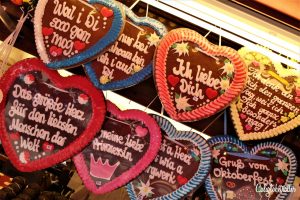
Christmas Specials
Weihnachts Plätzchen (Christmas Cookies)
During the Christmas season, Germans stay warm inside their houses by baking the colder winter days away. Some Plätzchen are so special, the dough has to be prepared months to weeks in advance. They come in all shapes, sizes and flavors and you can buy some at the Christmas markets or candy shops. Or perhaps you know a German who will bake some for you! Or you can try it yourself by buying a German Plätzchen cook book: Homemade German Plätzchen: And Other Christmas Cookies
Glühwein (Mulled wine)
Is a hot cup of red wine mulled with fruits served at every single Christmas Market during the holiday season! Occasionally, you’ll find other varieties with a white wine, or even an Apfel Glühwein which is made with hot apple cider. The next step up from Glühwein is Feuerzangenbowle – mulled wine with rum! This one ain’t for children! A small sugar cube soaked in rum, which will drip into a large copper pot after being set on fire, or even on your glass, giving your Glühwein that boozy feeling!
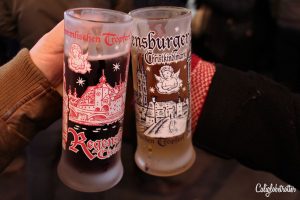
Gebrannte Mandeln (Roasted Almonds)
Often found at all festivals including Christmas Markets are the delicious variety of roasted and sugar coated nuts. Almonds are among the most popular, but sugary roasted macadamia nuts are delicious and addictive! You may even find little train-like stalls offering roasted chestnuts on a an open fire.
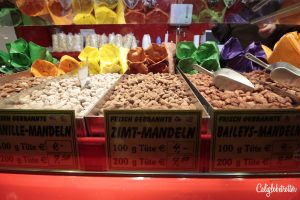
Lebkuchen
A classic Christmas cookie which can be found throughout German Christmas Markets which originated from Nuremburg is similar to gingerbread cookies. You’ll find them both in small packages of different flavors or in heart shaped cookies, typical for any festival in Germany.
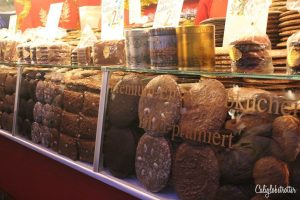
Stollen
No Christmas market is complete without this classic German fruit bread containing small pieces of dried fruit and with a heavy dusting of powdered sugar. Typically, this is can also be bought at any grocery store to be taken home!
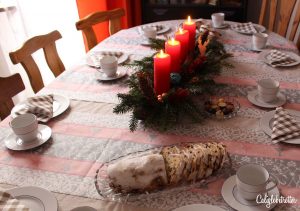
Below are the German / Bavarian cuisine cookbooks I use every single day while living in Germany which I often gift to friends and family who come for a visit and fall in love with Germany’s most traditional meals! I HIGHLY recommend any and all of them!!
 |  |  |  |
Disclaimer: This post contains affiliate links. If you click on one and make a purchase, I might make a little extra spending money, at no extra cost to you. As always, all opinions are my own and these products/services have been found useful during our travels and come highly recommended to you from yours truly!
More Delicious Foodie Posts:
A Delicious Guide to Coffee & Cake in Vienna
The COMPLETE Guide to the Kentucky Bourbon Trail

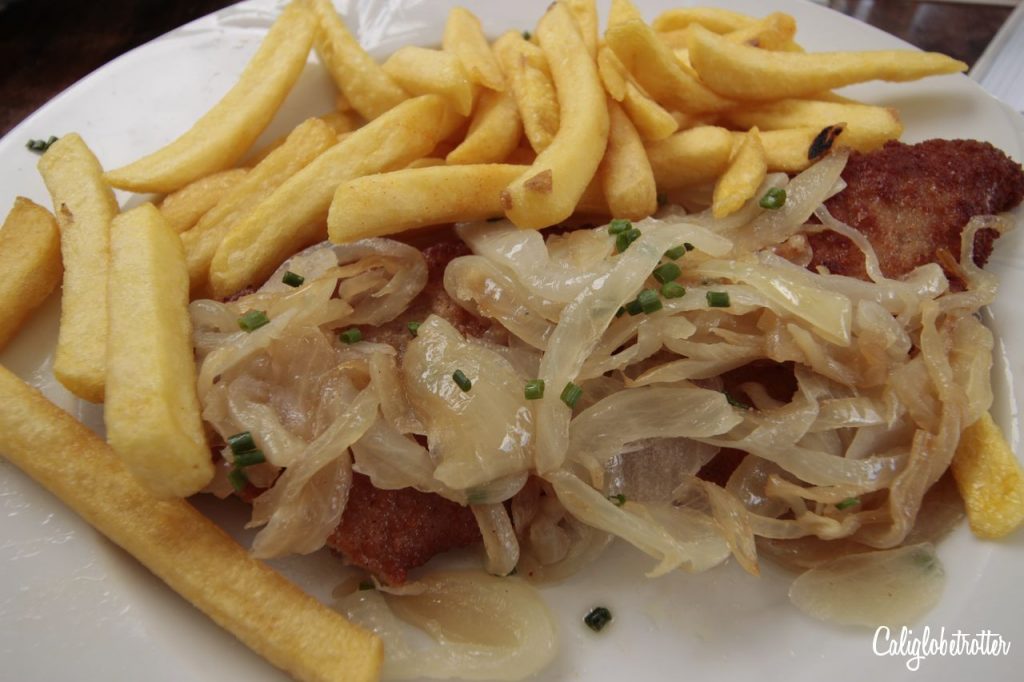


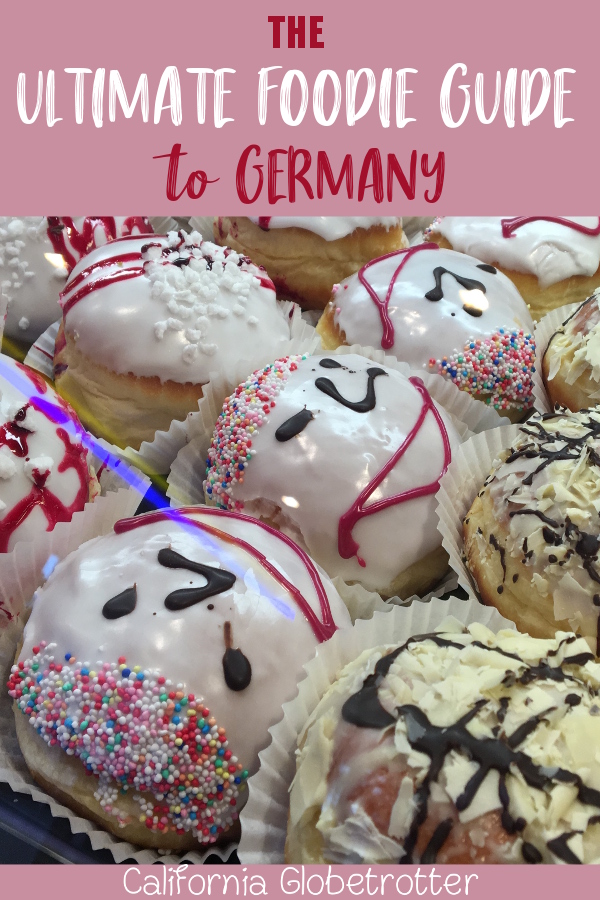
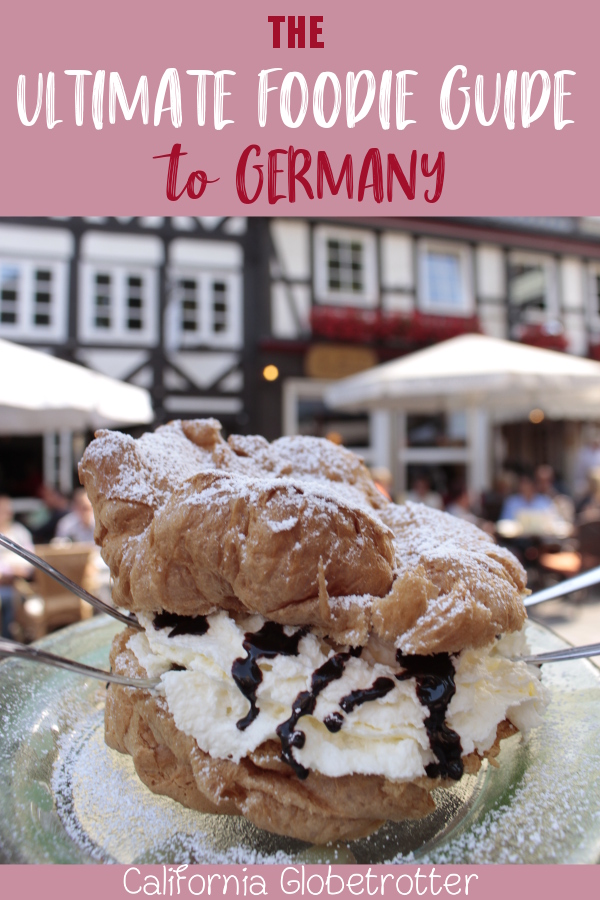




I wish I had seen this post a couple of months ago. We have just come back from four weeks in Germany and I must admit that we found the food confusing and eating out a bit of a trial.
Ah bummer! So sorry I didn’t post this sooner! It’s taken me almost a year to collect a lot of the pictures!
I’ll never forget when I was studying abroad and they brought out that white sausage exactly like you have it there. LOL I was flummoxed. It tasted like lemon and sage. I don’t know how I remember that. (Probably because no one had ever served me sausage floating in water.) I love a great German pretzel, strudel, and spit cake… I think I’d probably really like a schnitzel sandwich too. I’ve never noticed that on a menu before! Ahhh, I’m craving all the food now. Delicious.
Schnitzel sandwiches usually come at quick food stands – but I hope you liked your sausage!
Hi Lolo, What a great guide to some of the more common German foods you can find when traveling! I’ve tried many of these but so many left to try! I have never heard of the Spezi Coke drink before. That Baumstriezel looks good – a dessert to keep in mind for whenever we get back to Germany! Jessica
The Baumstriezel is a wonderful treat easily found at the Christmas Markets, if not also in Prague!
Wow, what a comprehensive post! I definitely tried a few of these – not riesling ice cream alas- when I lived in Germany and am missing quite a few right now. Seriously craving a pretzel! Thanks for linking up with #citytripping
I absolutely love all German sweets:) #citytripping
Thanks for the heads up! I’m going to have so much fun trying new things to eat on my first visit to Germany in a few months. Can’t wait!
Awesome have a great time!
Great post, there isn’t a country that can beat Germany for a sausage.
All quite hearty food, but I love it. #farawayfiles
This is an incredibly useful guide with such good explanations of all the different foods. The Germans sure do love their pork, don’t they? I’ve been to Germany a couple of times on vintage car rallies with my dad. It was often hot and I didn’t fancy eating lots of sausages but I found the selections of salads to be absolutely delicious. And then of course there’s the cakes! Fantastic share for #FarawayFiles
German salads are the one thing I hate! I can’t stand that my salad is either sweet or sour and I get no choice of dressing.
It’s so funny how Döner has turned into a proper German dish over the past 20 years. You can’t even find that kind of Döner in Turkey where it’s originally from. Great job collecting all these pictures and trying all these dishes – I think you’re already more German than I am. 😉
Haha I’ve been Germanized by my German husband!
Döner was actually invented in Berlin, not Turkey. 😉
According to Wikipedia:
It was not until a century later that döner kebab was introduced and popularized in Istanbul, most famously by Beyti Güler. His restaurant, first opened in 1945, was soon discovered by journalists and began serving döner and other kebab dishes to kings, prime ministers, film stars and celebrities.[11] It has been sold in sandwich form in Istanbul since at least the mid-1960s.[10]
In Germany, the döner kebab was popularized by Turkish guest workers in Berlin in the early 1970s.[15] The dish developed there from its original form into a distinctive style of sandwich with abundant salad, vegetables, and sauces, sold in large portions at affordable prices, that would soon become one of the top-selling fast food and street food dishes in Germany and much of Europe, and popular around the world.[16]
Thanks for the tempting guide to eating in Germany. Would love to try schneewittchenkuchen and windbeutel, when I do visit. #FarawayFiles
So many good options. I do love the pretzels with mustard. I didn’t know you eat them with sausage for breakfast. Sounds good, except not a beer fan. The drinks sound interesting, not sure about mixing orange and coke. The desserts look good, I think Black Forest cake is my favorite. #TheWeeklyPostcard.
Oh ya, and add a little butter to your pretzel and you’re set!
Ok I’m hungry now! At least now I know what I have to eat when I get to Germany! I have to try those neat wines though. #Theweeklypostcard
Whew! I sure am hungry now! LOL! Very interesting collection of foods. I especially liked the dessert section. That is fascinating that the gingerbread hearts can be kept and will not go bad. I would definitely indulge in the Rieseling ice cream. 🙂
That has probably been my fav!
I love German food except for the bratwurst (I know, what?!) My parents lived in Munich for three years and I loved eating all the German food when I went to visit. Even now when I go home to visit I always ask if my mom will make something German while I’m there. #FeetDoTravel
Haha homemade German food is always the best!
Have I ever told you that when I went on a work trip to Stuttgart my colleagues took me to an Australian restaurant – haha. Now the thing about German food is that it is not what I would consider light. I love all the pastries but after a few days of wurst and fries I am begging for veggies! #farawayfiles
This is true! There isn’t much healthy about German food and this is why we eat at home a lot!
Yes! Yes! Yes! Yes! We adore the simple and hearty German food, and find that eating out with kids is so much easier than with our more pretentious French neighbours. Still not totally convinced by Fleichkäse though… but everything else I’ll gobble up in an augenblick. Yum! #FarawayFiles
I knew even before opening this article that I am going to leave hungry! Estonian cuisine has borrowed heavily from German cuisine so some of it is really making me miss home. Sauerkraut, potatoes and schnitzels along with gingerbread and roasted almonds transfer me right back home. I can’t wait to stuff my face when I finally go in December. Yummy!
OMG, Lolo, this is such a mouthwatering post! I so love German food! Especially the meets and the sweets. We have a couple of good German markets in Los Angeles area where we can buy some of these delicacies, but they are not as good as in Germany. #TheWeeklyPostcard
Which is so strange because there’s so much German ancestry in the US, you’d think it’d be more authentic!
Oh wow, I should have read that after lunch. Some fabulous, delightfully delectable dishes on the list. I agree a great slice of the fun of travelling is experiencing different foods. 🙂
The pretzel and the white sausage looks great!. I’m going to keep an eye out for that next time I’m in Germany. #theweeklypostcard
That’s a pretty good list of foods! One thing is obvious: Germans sure love their pork. I would have hoped for more variety, considering the large number of Jews who lived there for so many centuries, but when I was there I didn’t see much evidence of it. I’ve got a friend who follows a Biblical diet and has been diagnosed with celiac and she finds living there quite a challenge.
Oh I believe it! Even eating a healthy diet is rough because your salad options are limited to rabbit salads.
My goodness so much deliciously decadent food in one post! Really interesting to see all the top dishes. I have tried a few in the past but now have a comprehensive list! I must say they do like their meat – and bread! Thanks for linking #citytripping
It’s funny how everyone says Germany has the best meat and bread! It’s so true though!
The cream puff — oh, my!!! And the snowball, which you can find in Regensberg! I will be on the lookout for these goodies during my trip to Germany in a few weeks. My mouth is already watering!
Awesome! Have a great time and eat lots of yummy food!
I’m veggie so I can’t appreciate all the meaty entries quite as much as the other half of Spud on the Run, but I’m saving this post for our next visit! Phil will be eating his way through the list, I’m sure, and I’ll be having a true cheese and cake fest washed down with mulled wine! AMAZING! … that pretzel photo… wow…
Thanks for sharing your German foodie faves! #FeetdoTravel
We are heading to Germany this summer … hungry already!
Awesome, have a yummy time eating your way through Germany!
Reading about German Food and having to go through all these food pictures makes me remember tasty experiences during our travels. Certainly, Germany’s food doesn’t help to loose weight. Some of the specialties I know from childhood in Switzerland, like the Bretzel. Most I miss the wonderful black bread which isn’t so easy to get in some parts of the world.
Germany does have some fantastic bread!
OMG yum!!!!!
Oh yes, we enjoyed some of these delicious dishes when in Munich for Oktoberfest. We would have white sausage for breakfast from the Lidl around the corner, then off to the festival where the boys would have a beer, and I had a radler. Ahhh they were the days … and obviously there is Bratwurst and Gluwein at the Christmas markets held all over the UK. I’m so hungry right now. #feetdotravel
Sorry not sorry! ?
Oh yum! There is literally nothing about this post that we don’t love and want to eat right now! (Could be that we’ve been trying to behave on our diet?) Seriously, we both have a fondness for sweets and that whole section is so tempting. We’re familiar with some of these dishes, but love trying new things. Especially when they look so good! Can’t wait to go exploring the foodie side of Germany. 🙂
Oooh sorry! Know how rough it is to stay good when traveling! Stay strong!
Um, can you come roll me to bed now?! ha! – I’m stuffed just going through this amazing collection of food! Definitely saving as a reference for my next trip to Germany. I first went as a college student about 25 years ago and was impressed with the food then. Of course it did not hurt that I loved sauerkraut and potatoes! I’m also now craving Black Forest cake and some glühwein. Thanks for sharing so much great information. #FarawayFiles
Always glad to make you crave Germany!
I went to Europe in 1977 with my high school German Club. We did a tour of all of the Capitals of the Common Market. When we were in Germany we went to Cologne to the Cathedral. We also went to a bakery within walking distance and I bought a piece of some kind of cream cake that was vanilla, three layers, the frosting was delicious and not too sweet. I’ve never forgotten it and I still have the extra napkins and wrapper tucked away with other souvenirs. Germany was beautiful and the food was wonderful. Lots of good memories all these years later. We did laugh a lot on that trip and made new friends. My brother-in-law and his family just moved back to the US after living and working in Germany for 5 years. I think his wife got some kind of fellowship at a university here. She is a biochemist and went to school while they lived in Munich. She also had two little girls who are the best kids ever. The older girl went to school here to be evaluated and she can write in cursive and print better than anyone the teacher has ever seen. And she is six years old. I think they miss Germany.
Oooh that cake sounds delish!! Will have to look for that when we visit Cologne one day!
Enjoyed reading your post about German food. My husband and I (both American) met in Bavaria and married while working there almost 20 years ago. We’re headed back there this Fall for the first time since we left. Your post and pictures were useful in helping me brush up on my German words and food! We’re hoping some of our favorite restaurants are still there so we can enjoy their food once again.
Enjoy your trip back to DE! Thanks for stopping by!